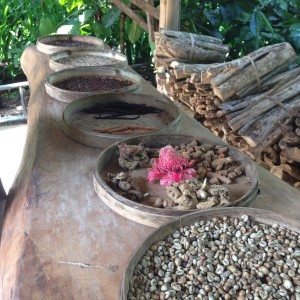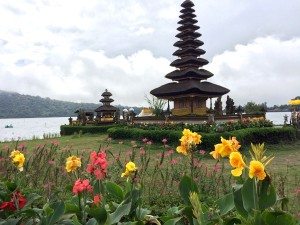 For the next installment in my Southeast Asia travel series, I took it upon myself to do some investigative research in the heart of central Bali. It was a tough job, but somebody had to do it 😉
For the next installment in my Southeast Asia travel series, I took it upon myself to do some investigative research in the heart of central Bali. It was a tough job, but somebody had to do it 😉
The biggest surprise for me was that Ubud was significantly bigger and more developed that I expected. It is very evident that Bali has been a Mecca for hemp-wearing, tempeh-munching ecotourists for decades if not generations. Prior to visiting, I imagined the place as synonymous with yoga retreats and did indeed see a large number of lycra and scarf clad yogis wandering about in search of some wheatgrass in downtown Ubud.
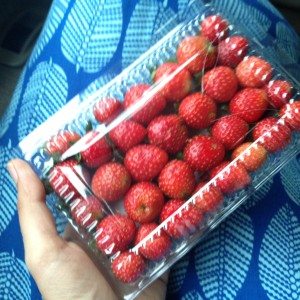
Local strawberries our driver bought for 50 cents because he said the lady would have charged us 5$.
Only having claimed independence shortly after WWII, Indonesia strategically designated Bali as a tourism hub, almost as if to say leave the rest of us alone. I may have sensed some local resentment about rich tourists disturbing the pristine beauty of the landscape and historical towns. Combine that with the “common knowledge” that all foreigners must be living it up like the Kardashians back home, and you are left with a practice of blatantly charging foreigners up to 10x the local price, and requiring fees to walk in parks and temples, drive down certain roads or park somewhere that locals can access for free. Imagine if you only had to pay tolls on I-90 if you were from out of state. Or imagine tourists had to pay to walk up and enjoy a view of Lake Michigan from Navy Pier. Let’s just say it gets old, and can add up fast.
On the plus side, English is widely spoken or at least understood, making travel much easier than Indonesia’s second most popular tourist destination of Batam.
But Erin, what about the gluten-free food? Finding a hippie cafe offering a clearly labeled vegetarian and gluten-free menu was not difficult. So from that stand point, it is a relatively easy place for someone with dietary restrictions to at least get by. Due to the rampant tourism, experiencing truly local food seemed to require really good connections that could get you past the bland and dry presentations of the “local specialties” of roast duck and suckling pig that are offered up next to club sandwiches at hotels and cafes with an English menu.
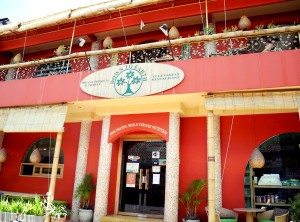
Surprisingly big portions of organic, vegetarian fare.
Not wanting to miss out on the “local specialties”, I went ahead and ordered those, but due to the communication barrier the best I could do to avoid soy sauce was to request “no sauce” and pray that the meat wasn’t marinated in soy sauce (it didn’t appear to be). A couple of times I passed on some veggies that were delivered to the table swimming in a suspicious dark liquid. All in all, for a gluten-avoiding traveler I would say you really aren’t going to miss anything if you stick to the hippie cafes. In fact, the best thing we ate was some rice-flour battered and fried cauliflower and broccoli at a crunchy establishment called Down to Earth Cafe. If you can afford to be more adventurous, then have at it. (Unrelated side note about adventurous eaters: I met a couple of girls in Bangkok last weekend who had just recently gotten over a bad episode of food poisoning, but who were still willing to sample the street-food. God bless them.)
Now just looking at the menu, we could tell this was going to be a tourist trap, but how can you resist a view like this?
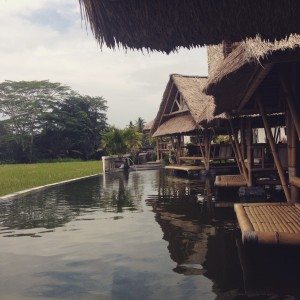
Peaceful lunch overlooking rice paddies.
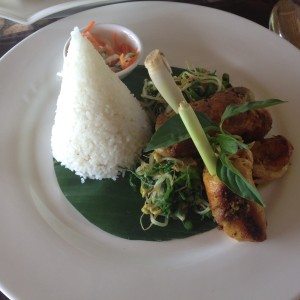
This one was pretty but made me nervous.
The best meal we had was at the Taksu cafe after a luxurious afternoon at the spa. At this point we were already disillusioned with the touristy versions of Balinese food and opted instead to take advantage of the fresh and organic offerings at the spa’s cafe.

Grilled shrimp skewers over cauliflower and broccoli.
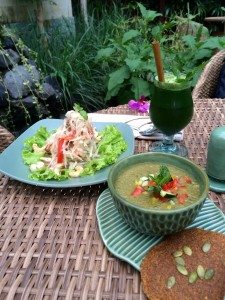
Green papaya salad, a yummy gazpacho and of course the required green juice.
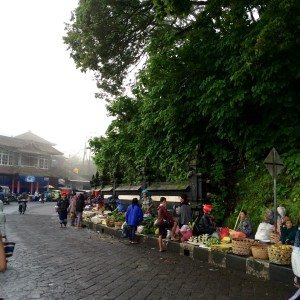
Away from the bustle of Ubud, vendors were set up long before sunrise.
According to our very sweet driver, real Balinese food is cooked fresh in large quantities (maybe making it difficult to serve in restaurants?) and deliciously spicy. There were roadside markets bustling with activity as we headed out on an early morning tour at 5am, so clearly SOMEBODY is eating their veggies. If I ever go back, I would try to take a cooking class like this one: http://www.paon-bali.com/. The upside of doing that is you have better odds of being able to try things with confidence that they are safe for you to eat – and maybe learn a thing or two while you are at it!
So all in all, it was a fun, whirlwind of a 3-day trip. We saw more sights than we expected to and if I sound like I have some culinary regrets, at least I learned something and can hopefully make your trip even better. To summarize for my gluten-free friends, I would recommend either sticking to the organic, health-food oriented places because there are plenty of nice options there and/or dive in with a cooking class (or if you are really lucky, make friends with someone who will invite you over for a family dinner).
The coolest new food that we tried was the snakeskin fruit. It has a strong aroma, firm texture and very sweet taste.
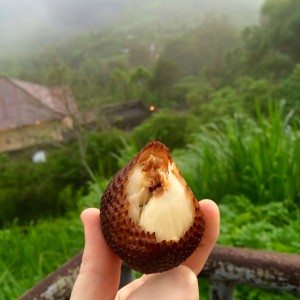
“snakeskin fruit”
Eating a fresh passion fruit with a spoon was pretty cool, too.
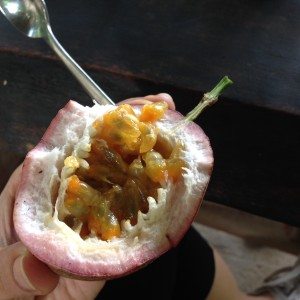
Have you ever tried passionfruit? I had not…
That was at a tiny little farm that grows coffee beans, vanilla, ginger, various fruits and spices:
Parting tips:
1. Hire a driver based on trusted recommendations to avoid getting scammed. Here is the contact information for ours, who came highly recommended by a friend of mine. He was very responsive via text and email, accommodating and reliable. He and a driver from his team, simply asked what types of things we were interested in seeing and arranged a private, custom tour from there. Made life very easy!
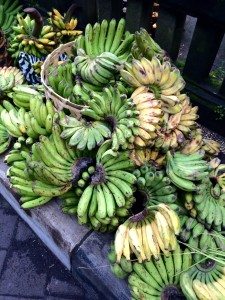
July Seven Tour & Travel Company
(owner’s name is Dewa Adiwisma)
Monkey Forest Rd. 80571 Ubud, Bali
Phone: +62-361-974106
Mobile: 081-23913992
email: adiwisma@yahoo.com
2. Bring US currency. Some places give you a better exchange rate to use dollars and some a very bad rate so just be aware of the going rate. Also, everyone I talked to agreed the 1: 12,785 exchange rate from USD to Rupiah requires a little mind bending, so don’t feel bad if you have to take a minute to digest when someone gives you a price in millions.
For more on traveling safely with gluten allergies check out the other travel posts and subscribe to my bi-weekly newsletter where I share my best advice for thriving on real food (and more)!
Oh, oh…ok here you go…the one local food that Ubud was more than happy to share with tourists was the 5 dollar cat-poo-chino. (Google “Luwak Coffee” if you don’t know what I am talking about. And no, we didn’t try it! 😉
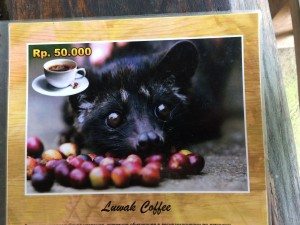
Cat-poo-chino…yup


